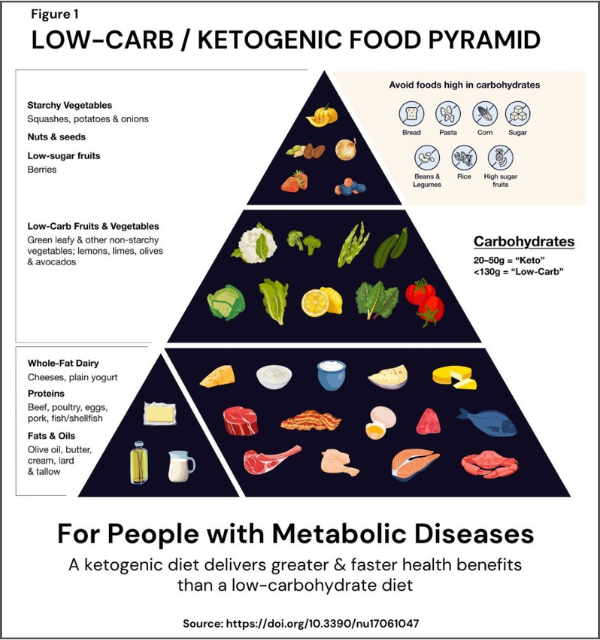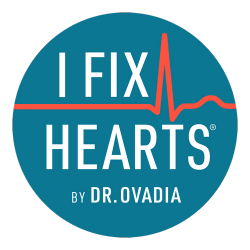I’ve talked a lot about food pyramids during my career — but in the last decade or so, I’ve been actively speaking out against them. It’s been my experience that poor dietary guidelines have kept Americans confused, sick, and unhealthy.
That’s why today I’m happy to flip the narrative on its head and speak about guidelines in a more positive light. Thanks to the tireless efforts of low-carb medical professionals, we’ve seen the first-ever publication of a proper human food pyramid.
First: defining a proper human diet
A proper human diet consists of eating whole, real foods that come from that ground or eat things that grow on the ground. This means no ultra-processed food, no added sugar, and no unhealthy preservatives or oils like seed oils.
There are many different diets that fall under this umbrella. However, there are at least three things they share in common:
- They are typically low-carb
- They are mostly animal-based
- They usually avoid foods with ingredients labels
This, of course, is different from most traditional food pyramids. The most recent guidelines make carbohydrates a staple of your diet and minimize dairy, protein, and healthy fats.
By now we know this is a flawed way of thinking. As the research shows, it’s also been killing us. Avoiding protein, adding carbohydrates, and shying away from dietary cholesterol has been a major contributor of obesity and heart disease over the past 50 years.
The good news is that more and more doctors are exploring how food influences metabolic health. This includes incredible low-carb professionals like Drs. Nina Teicholz, Tro Kalayjian, David Unwin, Cate Shanahan, and Mariela Glandt.
The chart below is a culmination of their peer-reviewed efforts, which is called Myths and Facts Regarding Low-Carbohydrate Diets. You can read the full article published in Nutrients, which discusses common concerns related to low-carb diets and their positive effect on chronic disease.

Now, let’s take a closer look at how this works.
A closer look at the proper human food pyramid
There are five different layers of the proper human food pyramid:
Primary base: Animal protein
Animal-based protein is the number one component of a healthy human diet. Ruminant meats like beef and lamb are best, although chicken, turkey, pork, and wild meats (like venison) are also optimal.
Seafood is another important staple. Fatty fish like salmon and tuna are optimal, as well as nutrient-dense shellfish like lobster, shrimp, and crab.
A good way to gauge how much to eat is by setting a protein goal. This is usually around one gram of protein per pound of your goal weight, so ~150 grams per day — much higher than the Standard American Diet suggestion.
Secondary base: Animal fats and dairy
Healthy fats are a must for proper metabolic health. However, not all fats are created equal.
On a proper human diet, you should focus on:
- Butter
- Lard
- Tallow
Seed and vegetable oils like canola, peanut, and corn should be avoided.
If you’re looking for plant-based options, coconut oil, olive oil, and avocado oil are passable. Just remember that animal fat often contains higher concentrations of trace vitamins and minerals.
Also included on this list are dairy products like cheese, yogurt, and cream. These are low-carb staples that should be consumed as unprocessed as possible, which means no added sugar, flavorings, or preservatives.
Drinking milk is largely a personal choice. Even healthier options such as grass-fed raw milk are higher in carbohydrates per serving than starchy vegetables. However, studies show it may potentially lower glucose levels, and some people are more tolerant of drinking milk than others.
Staple: Low-carb fruits and vegetables
Similar to traditional food pyramids, leafy greens and cruciferous vegetables should have a sizable place in the average diet. Popular options include lettuce, broccoli, and cabbage, as well as fruits like tomatoes, olives, and lemons.
Remember that this food pyramid was designed for eating between 50 and 130 grams of carbohydrates per day. If you’re following a carnivore, warrior, or lion diet, you may opt to avoid leafy vegetables (aka carbohydrates) altogether.
Which leads to the next point:
Minimal: Marginal carbohydrates
Some foods are technically whole and real, but are higher in carbohydrates than other potential choices. It’s best to consume these in moderation and make them a smaller portion of your overall diet.
This includes:
- Nuts and seeds: They might be keto staples, but they technically contain carbohydrates. You should also consider their oxalate count, which could potentially worsen any autoimmune or chronic conditions.
- Starchy vegetables: While minimally processed, root vegetables like potatoes and yams are often high in carbohydrates. Any root vegetable (think beets, carrots, and sweet onions) will have more carbohydrates than other plants.
- Low-sugar fruits: Strawberries, blueberries, and raspberries should be consumed in moderation. This isn’t to say that low-sugar fruits are somehow worse for you than processed foods (far from it). However, it’s a good idea to be mindful of your consumption. It’s much easier to overeat a pint of blueberries than it is a pound of beef, for example.
Avoid: High-carb and processed foods
Staying away from high-carb food means avoiding things like:
- Flour
- Corn
- Rice
- Sugar
- Beans and legumes
- High-sugar fruits (like pineapple)
It’s true some of these foods are technically whole and real. However, they are still high in carbohydrates, which should be avoided in heavy amounts. That doesn’t mean you can’t enjoy the occasional corn on the cob — just be mindful of the cumulative amount of carbohydrates you’re consuming, being mindful that sources are more than just bread and pasta.
Processed foods are also included on this list, which includes anything that has been significantly altered from its natural state. A good rule of thumb is to avoid anything with added sugar, preservatives, and artificial flavors. If it’s been heavily treated with heat and chemicals (think prepackaged cookies or fruit roll-ups), it should be limited or avoided altogether.
Adjusting to a proper human diet
The proper human food pyramid looks very different from the dietary guidelines we’re used to. And yet, it’s already changing lives.
The principles are simple: eat lots of animal protein and supplement with dairy and fat. If desired, add leafy greens and the occasional low-carb berry. Limit starchy roots, nuts, and seeds, then avoid high-sugar fruits and process foods.
And just like that, you’re eating a proper human diet.
I realize this may be easier to follow with a specific low-carb diet in mind. As mentioned, there are typically three popular options that fall under the umbrella. If you’re not sure which option makes sense for you, explore my guides to the most common ones here:
